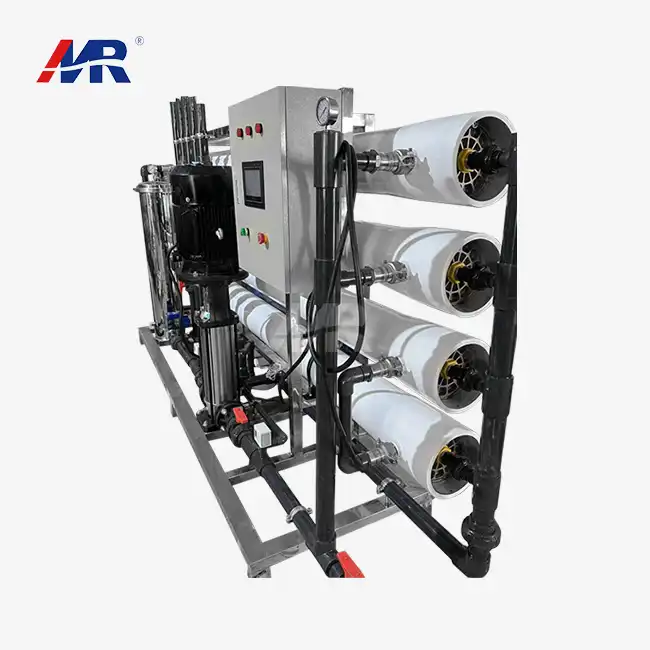USP Purified Water Standards for Pharma RO Plants
The United States Pharmacopeia (USP) establishes strict guidelines for the quality of water used in pharmaceutical production. These standards are fundamental to ensuring that pharmaceutical products are both safe and effective for consumer use. Water, being a primary ingredient in many drug formulations, must meet these rigorous requirements to prevent contamination and ensure the quality of end products.
Key USP Requirements for Purified Water
USP standards for purified water in pharmaceutical production encompass several critical parameters:
- Total Organic Carbon (TOC) Content: Should not exceed 500 ppb, as organic compounds can interfere with pharmaceutical processes and product integrity.
- Conductivity: Must be ≤ 1.3 µS/cm at 25°C, ensuring that dissolved salts and ions are within acceptable levels.
- Nitrates: Should not exceed 0.2 ppm, as high nitrate levels can be harmful to human health.
- Heavy Metals: Should be kept ≤ 0.1 ppm to avoid toxic contamination.
- Microbiological Quality: Must have ≤ 100 CFU/mL, ensuring that water is free from harmful microorganisms that could contaminate drugs.
To comply with these stringent USP standards, pharmaceutical reverse osmosis plants typically employ multi-stage filtration processes. These include pre-treatment, reverse osmosis (RO) membranes, and post-treatment stages, all of which must be meticulously monitored and validated. Regular water quality checks are crucial for maintaining compliance and ensuring that the water used in drug production meets all safety and efficacy requirements.
Why Pharmaceutical-Grade RO Systems Need Double Passes
Double-pass reverse osmosis systems have become essential in pharmaceutical production due to their ability to meet the rigorous water purity standards required for drug manufacturing. This two-stage filtration process passes water through two separate RO membrane stages, significantly improving the removal of contaminants, dissolved salts, and other impurities.
Benefits of Double-Pass RO in Pharma Production
The primary advantage of using a double-pass RO system is its ability to achieve ultra-pure water. This is crucial in the pharmaceutical industry, where even trace impurities can compromise the quality of products. Double-pass systems effectively remove ions, organic compounds, and other contaminants, ensuring water quality that consistently meets or exceeds industry standards.
Another key benefit is the system's enhanced resilience. With two stages of filtration, the system is less susceptible to variations in feed water quality, ensuring stable performance even when water sources fluctuate. Additionally, this configuration provides an added layer of protection against microbial contamination, which is critical for pharmaceutical applications.
For manufacturers, double-pass systems offer greater compliance with stringent regulatory standards like USP, FDA, and others. By achieving such high purity levels, pharmaceutical companies can enhance product safety and quality, providing a reliable foundation for producing sensitive medications and formulations.
Validating Water Purity in Medical BWRO Plants
Brackish Water Reverse Osmosis (BWRO) plants are increasingly utilized in pharmaceutical production, especially in regions where freshwater sources are limited. These systems are designed to treat water with higher salinity levels, making them versatile solutions for various pharmaceutical manufacturing scenarios.
Validation Protocols for Medical BWRO Systems
Ensuring the purity of water produced by a BWRO plant in medical applications requires rigorous validation protocols. Key aspects of the validation process include:
- Comprehensive water quality testing at multiple points in the system
- Continuous monitoring of critical parameters such as conductivity and TOC
- Regular microbial testing to ensure biological control
- Validation of cleaning and sanitization procedures
- Periodic performance qualification of the RO membranes and other system components
Implementing robust validation protocols is essential for maintaining the integrity of the water purification process and ensuring compliance with regulatory requirements. This involves a combination of online monitoring systems, laboratory testing, and thorough documentation of all quality control measures.
Advanced Monitoring Technologies for BWRO Plants
Modern BWRO plants in pharmaceutical settings often incorporate advanced monitoring technologies to ensure consistent water quality. These may include:
- Real-time TOC analyzers
- Inline conductivity meters
- Particle counters
- Automated sampling systems
- Data logging and trending software for quality assurance
By leveraging these technologies, pharmaceutical manufacturers can maintain strict control over their water purification processes, quickly identify any deviations from established parameters, and take prompt corrective actions when necessary.
In conclusion, the use of RO systems in pharmaceutical production is essential for maintaining the highest standards of water purity and product quality. From meeting USP requirements to implementing double-pass configurations and validating BWRO plants, these advanced water treatment technologies play a critical role in ensuring the safety and efficacy of pharmaceutical products.
Are you looking to upgrade your pharmaceutical water purification processes? Guangdong Morui Environmental Technology Co., Ltd. specializes in cutting-edge water treatment solutions tailored for the pharmaceutical industry. Our state-of-the-art reverse osmosis systems, including high-capacity 60m³/hour plants, are designed to meet the most stringent quality standards while offering exceptional efficiency and reliability. With our comprehensive services encompassing equipment supply, installation, commissioning, and after-sales support, we ensure a worry-free experience for our clients. Let our team of experts help you achieve and maintain the highest levels of water purity for your pharmaceutical production needs. Contact us today at benson@guangdongmorui.com to discover how our innovative RO solutions can elevate your manufacturing processes.
References
1. United States Pharmacopeia and National Formulary (USP-NF). "Water for Pharmaceutical Purposes." USP43-NF38, 2020.
2. World Health Organization. "Good Manufacturing Practices: Water for Pharmaceutical Use." WHO Technical Report Series, No. 970, Annex 2, 2012.
3. American Society of Mechanical Engineers. "Consensus on Operating Practices for the Control of Feedwater and Boiler Water Chemistry in Modern Industrial Boilers." ASME, 2015.
4. Pharmaceutical Engineering. "Water Systems: The Backbone of Pharmaceutical Manufacturing." Vol. 38, No. 3, May-June 2018.
5. Journal of Membrane Science. "Advanced reverse osmosis membranes for water purification: Chemistry, performance and applications." Vol. 587, 1 October 2019.
6. European Medicines Agency. "Note for Guidance on Quality of Water for Pharmaceutical Use." CPMP/QWP/158/01 Revision, 2020.

_1745823981883.webp)


